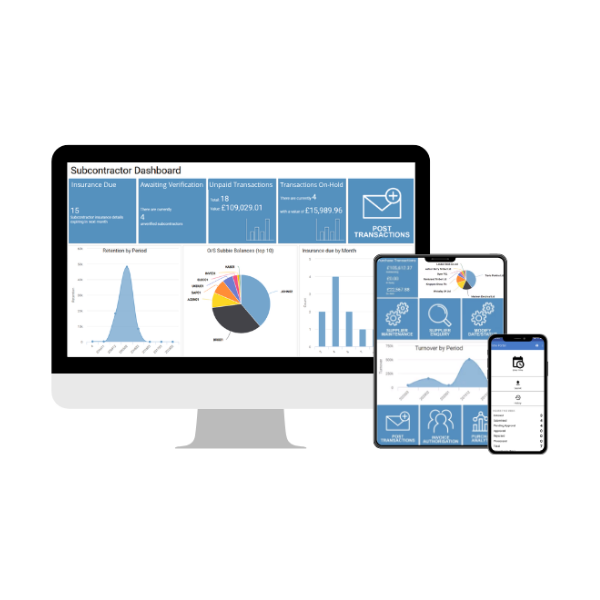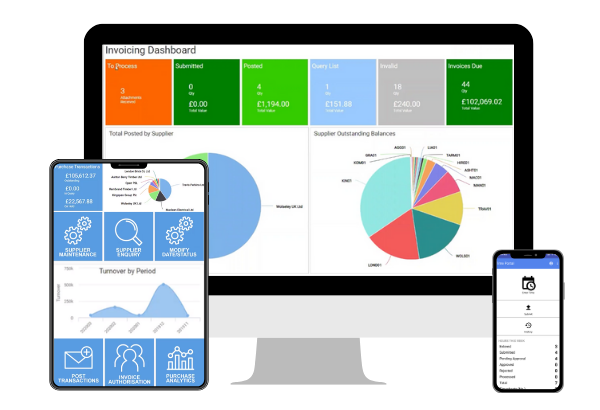Award-Winning Construction Accounting Software
- Track and manage job costs
- Save time on financial processes
- Increase profit margins
Take full control of your construction business with Evolution Mx – an all-in-one, easy-to-use construction accounting system. Manage every aspect of your projects, from budgeting and cost tracking to reporting and compliance, all in one powerful construction accounting software platform built for the industry.

Construction accounting software to suit your business, whatever the size and scope

Evolution Mx Lite
£1m - £10m turnover
Perfect for small and start-up construction companies looking for industry-specific accounting and management software, what’s more, the Lite version of our construction accounting software offers the convenience of monthly rental pricing, billed quarterly – with a fixed initial contract period for peace of mind.

Evolution Mx Standard
£10m - £100m turnover
Ideal for small to medium businesses, Standard encompasses our award-winning core features and can be enhanced even further with optional modules to suit your business.

Evolution Mx Enterprise
£100m+ turnover
With Enterprise you’ll get all of the Standard features, plus much more. This is a highly powerful and customisable construction accounting software package that’s best suited to large construction businesses requiring powerful reporting & substantial user scalability options.
Construction Accounting Software That Puts Project Profit First
Streamline your financial management with construction accounting software trusted by over 1,000 construction companies across the UK and Ireland.
Generic accounting tools like Sage or Xero often fall short when it comes to managing complex construction projects. The construction industry demands specialist accounting features, such as handling retentions, applications for payment, certifications, valuations, subcontractor management, the Construction Industry Scheme (CIS), and much more.
Our purpose-built construction accounting software simplifies these processes, bringing everything together in one easy-to-use platform. Boost your efficiency, improve productivity and maximise profitability with software designed specifically for construction businesses.


Keep Your Construction Projects On Budget
Did you know that large construction projects can exceed budgets by up to 80%?* Without the right tools, it’s easy to lose control of project costs – but the right construction accounting software can make all the difference.
Evolution Mx is purpose-built for the construction industry, giving you full visibility and control over your project finances. Track costs in real-time, manage budgets effectively, and reduce the risk of unexpected overspending. With Evolution Mx, you can complete more projects within budget and improve your profitability.
Don’t let your construction business become part of that 80% statistic. Take control with construction accounting software designed to meet the unique challenges of your industry.
*Source: McKinsey & Company
Construction Accounting Software Designed for Your Industry
Evolution Mx by Integrity Software is a fully scalable, modular construction management platform, built to improve efficiency for construction businesses.
Trusted by contractors, subcontractors, property developers, civil engineers and fit-out specialists, Evolution Mx brings your Finance, Commercial, Operational and Site teams together in one powerful system. Streamline your processes, improve collaboration and gain total visibility across your construction projects – all with software designed specifically for the construction industry.
Construction Financials
Take advantage of a construction-specific solution that seamlessly integrates core accounting ledgers with industry-specific payroll and reporting needs.
Business Analytics
Access real-time project insights from anywhere with our cloud-based technology. Our powerful dashboards keep you connected to your projects, providing clear, up-to-the-minute information no matter where you are.
Invoice Register
Go paperless with our Invoice Register and save time while efficiently tracking all your invoices. Reduce overheads, enhance transparency, and streamline your invoicing process.
Payroll & HR
Our payroll and HR modules simplify construction payroll management. Tailored to your business, they also seamlessly reconcile data with contract costings for complete accuracy.
Cost Value Reconciliation
Streamline and standardise your company’s CVR processes with our dedicated CVR module.
Additional modules
Enhance your team’s efficiency with a variety of additional modules, designed specifically for the construction industry. Seamlessly integrated with your Evolution Mx system, these modules lighten the load and boost productivity.
Having researched the market place and looked at a number of systems, we felt that Integrity offered the best solution for our business. Integrity spent a lot of time with us understanding our business needs and requirements. They then proposed a solution which was the perfect fit, offering a number of cost saving options that would further increase productivity. It was good to speak to a software supplier who understood our business sector.
Frequently asked questions
How is construction accounting software different to generic software?
Generic accounting systems like Sage, QuickBooks, and Xero
may offer basic financial functions, but they fall short when it comes to
meeting the unique demands of the construction industry. From managing
subcontractors and job costing to handling retentions and valuations, these
systems lack the specialised tools your construction business needs.
Without a dedicated solution, your business must rely on
numerous manual processes to cover essential construction-specific
requirements. Does any of this sound familiar?
- Manually
verifying and managing subcontractors via the HMRC/ROS online system
- Tracking
job costs across multiple spreadsheets, leading to errors and
inefficiencies
- Losing
track of retentions, meaning missed revenue opportunities
- Going
over budget on projects because your accounting system doesn’t provide
clear visibility of costs vs. budget, resulting in tighter margins
Evolution Mx construction accounting software solves these
challenges by streamlining key construction processes, reducing manual tasks,
and improving accuracy across your entire operation.
Stop wasting time with generic accounting tools like
QuickBooks, Xero and Sage. Switch to Evolution Mx – powerful, industry-specific
construction accounting software designed to make your business more efficient,
productive, and profitable. You’ll save time and money with construction
accounting software built for your industry.
What construction-specific features does Evolution Mx have?
Packed with features tailored for construction businesses, Evolution Mx helps you streamline operations and cut costs:
- Track job costs with ease – eliminate manual spreadsheets and gain real-time visibility of your project finances.
- Simplify subcontractor management – verify and pay subcontractors directly through Evolution Mx, with integrated HMRC (CIS) and ROS (RCT) submissions, plus seamless payroll for both the UK and Ireland.
- Stay compliant with Making Tax Digital – quickly submit VAT returns and avoid penalties with built-in MTD compatibility.
- Centralise your documents – store all business documentation in one secure location, ensuring your team always works from the latest version.
- Save time on reporting – users report saving an average of 2 days per month with our intuitive dashboards and easy-to-configure reports.
- Automate invoice processing – receive purchase and subcontractor invoices directly into your accounting system via a dedicated email address. Process them efficiently through an approval workflow, and speed things up even more with our optional OCR add-on to automatically capture invoice details.
With Evolution Mx, you’ll spend less time on admin and more time growing your construction business.
What makes Evolution Mx stand out?
It’s fully customisable to suit the size and specific needs of your business – and it grows with you. As your construction company scales, you can trust Evolution Mx to scale alongside you, providing the flexibility and peace of mind you need to manage larger, more complex projects.
The most successful construction companies understand the value of dedicated construction accounting software and adopt it early to gain a competitive edge.
If you’re still relying on generic accounting systems, now is the time to make the switch. Save time, reduce manual processes, and future-proof your business with Evolution Mx – the trusted construction accounting software for growing construction businesses.
How can construction accounting software help my business?
Whether you’re in the office, on-site, or working from home, our software ensures you’re always connected and in control.
- Tired of managing spreadsheets?
- Struggling to stay on top of contract costs?
- Constantly going over budget?
Evolution Mx construction accounting software can solve these problems by providing real-time visibility and helping you track costs, manage budgets, and streamline operations – wherever you are.
Ready to take your business to the next level? Book your free demo now and experience the best construction accounting software available.
Can I access my construction accounting software from anywhere?
Keep your teams connected, whether they’re on-site, working remotely, or on the move. Evolution Mx is a browser-based construction accounting system, designed for flexible, mobile working. Access critical project data securely from any device, wherever you are. With Evolution Mx, your construction teams can stay fully connected and in control, with real-time access to financial and project information via their web browser or mobile device.
Can I customise my construction accounting software to suit my business?
Every construction business has unique financial management needs. That’s why Evolution Mx comes with 7 essential core modules designed for the day-to-day financial operations of your business.
But we don’t stop there. Our software is fully customisable with a wide range of additional modules that let you tailor the system to your specific requirements. Manage everything from fixed asset depreciation to cost value reconciliations, and much more – all within one powerful platform.
Evolution Mx’s flexibility ensures your construction accounting software grows with your business, providing exactly what you need, when you need it.
Book your demo today
If you want to find out more about our construction accounting software and whether it is right for your business, please send us your details and we will be in touch soon.
